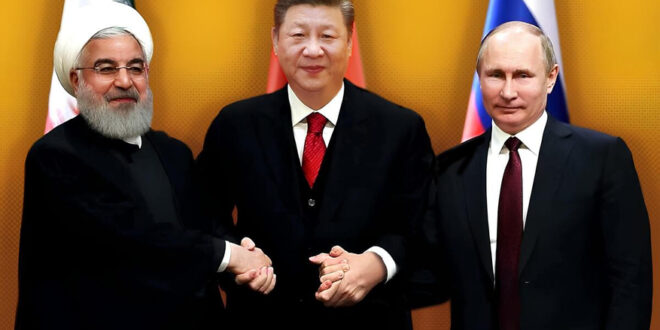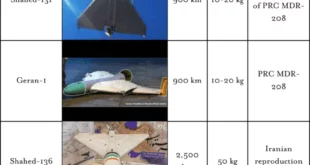Iran has transferred a batch of ballistic missiles to Russia, the White House claims . This is yet another proof of how a new anti-Western bloc CRINK (China, Russia, Iran, North Korea) is forming before our eyes, says military expert Colby Bedworth. The war in Ukraine has pushed these countries to expand military cooperation: Russia receives missiles and ammunition from North Korea, and uses Western components imported through China in the production of its own missiles and military equipment. The US National Defense Strategy names these countries as the main threats to American security. But while the “axis of evil” is strengthening cooperation, Western countries are inactive, allowing the enemy to build up its potential. According to Bedworth, the US should abandon the policy of de-escalation and move to more decisive actions, in particular, tighten the sanctions regime (including the use of secondary sanctions), allow American military contractors to work in Ukraine, and help Israel launch a retaliatory strike on Iranian facilities.
“Axis of Shock”
The free democratic world has faced many threats throughout its history. During World War II, it was the Axis powers. During the Cold War, it was the Warsaw Pact countries led by the Soviet Union, or as President Ronald Reagan called it, the “evil empire.”
Today, the Western world faces an even more serious challenge – from the CRINK “coalition.” This acronym, coined a year ago by Halifax International Security Forum President Peter Van Praagh, includes China, Russia, Iran, and North Korea, the countries that the U.S. National Defense Strategy identifies as the top threats to America.
In April of this year, the Center for a New American Security proposed an alternative to the term CRINK: the “Axis of Upheaval.” But whatever we call them, the point is the same: these four adversaries to the U.S.-backed world order are not disparate regional threats, but an emerging united front. And while they may not formally form a military alliance, that doesn’t stop them from working closely together to advance their shared interests.
Bilateral relations within CRINK have been developing before, but the scale of cooperation has grown significantly in the last two years. Multilateral cooperation is also expanding, one example being the joint naval exercises of Russia, Iran and China that took place earlier this year .
But the most striking evidence of this new axis is Russia’s war against Ukraine. Russia receives constant – and growing – material support from its CRINK allies. Munitions from Iran and North Korea, as well as dual-use goods from China, keep the Russian war machine going.
Munitions from Iran and North Korea, as well as dual-use products from China, keep the Russian war machine going
When Moscow began its “special military operation,” it did not expect that it would need outside help to succeed—just as the Kremlin’s partners did not expect that they would have to provide it. The growth of CRINK arms sales is partly a consequence of the failure of NATO and other allied states either to contain the process or to resort to more forceful measures when containment fails.
After it became known in January 2024 that Russia had used North Korean ballistic missiles against Ukraine, I wrote in a column for The Insider that the United States should act immediately to prevent Russia from completing negotiations to acquire missiles from Iran as well. This required convincing South Korea to directly supply Ukraine with lethal weapons, and convincing the United States to significantly increase its supply of long-range missiles to Kiev. But neither happened, and Russia ended up with Iranian ballistic missiles.
The DPRK, already a pariah, can hardly be influenced. Vladimir Putin’s calculations are another matter. If he thinks he can get away with something, he will do it. However, if Putin’s trips to Pyongyang resulted in Ukraine gaining access to South Korean military products Hanwha and Poongsan, Putin’s deals with Kim Jong-un would become meaningless.
South Korea has a vested interest in ending the arms trade between Moscow and Pyongyang. In exchange for a large quantity of ammunition (low quality, however), North Korea expects to receive access to missile technology from Russia, which is of great concern not only to Seoul, but also to Washington.
In exchange for large quantities of ammunition, North Korea hopes to gain access to missile technology from Russia
After the signing of the Russia-North Korea Comprehensive Strategic Partnership Treaty in June, South Korean authorities said they would consider providing Ukraine with lethal weapons. Several months have passed since then, but no decision has been made. This indecision helps CRINK countries increase their military cooperation.
The West’s doubts become their weapon
Russia, China, North Korea and Iran are boldly escalating as the Biden administration agonizes over every next step. The combined economic and military might of NATO and other allies like South Korea, Japan and Australia far outweighs CRINK’s potential. But what does that matter if the West is afraid to use it?
Each of these countries uses its own methods of blackmail. For Russia and North Korea, it is nuclear sabre rattling, for Iran, it is a vast network of terrorist proxies, and for China, it is economic dominance, which, however, is also a weak point. Although Beijing declared in February 2022 that its partnership with Russia “has no borders,” it has been cautious in supporting the Russian invasion of Ukraine all this time.
Being much more deeply integrated into the global economy than Russia, China is more afraid of sanctions. Therefore, China’s material support for its northern partner has in fact been limited to dual-use goods and has not included military exports.
However, there are already signs that Beijing is losing its caution: Russian troops are now armed with Chinese armored vehicles. China’s supply of dual-use products and other measures to circumvent sanctions should not go unnoticed either.
Chinese support has played a major role in Russia’s ability to manufacture its own missiles using Western components . The US’s targeted sanctions against some Chinese firms involved in the illegal trade in missile components are clearly not enough. As with North Korea, these half-hearted measures only encourage Russia and China to cooperate more closely. It is high time to stop this.
Last month, Deputy Secretary of State Kurt Campbell appeared to take a first step in that direction, noting that Beijing was providing “very significant” assistance in building and diversifying elements of Russia’s military machine. Campbell also outlined what China was getting in return.
“The opportunities that Russia provides are support in areas where the Russians have previously been frankly reluctant to engage directly with China… We are talking about submarine and aviation technologies, including stealth, as well as missile developments.”
The potential transfer of submarine technology is certainly worrying the Pentagon. It is an area where both Russia and the US retain significant technological superiority over China. However, Campbell’s shocking revelation has not been followed by a tightening of sanctions policy. And although Washington has stepped up its military support for Taiwan, so far this has not led to any changes in Beijing’s behavior.
Unlike China, Iran openly provides military support to Russia. Iranian Shahed drones have been used on Ukrainian territory since the fall of 2022 and have already become a daily threat to the country. The US, UK and France have acknowledged that Iran violated the UN Security Council resolution by handing over these drones to Russia, but the response from Western powers, as usual, was only minor additional sanctions.
When UN sanctions expired a year ago, Iran began negotiations to hand over ballistic missiles to Russia. Unlike the weapons from the DPRK, the quality of which is highly questionable, the “shaheeds” proved to be an effective weapon of terror, forcing Ukraine to pull its air defenses away from the front lines.
The “Shaheds” proved to be an effective weapon of terror, forcing Ukraine to pull its air defenses away from the front line.
Iran’s short-range ballistic missiles (SRBMs) have not yet been tested in combat in Ukraine, but have previously proven their effectiveness in Iraq. In exchange for the UAVs and missiles, Iran has agreed to purchase Russian Su-35 fighters and has already received advanced Yak-130 jet trainers.
The Su-35, one of the most modern examples of Russian aircraft, will be a valuable acquisition for the Iranian Air Force. Exchanging short-range missiles for modern fighters is a reasonable deal for the Islamic Republic’s army: SRBMs have a limited range when launched from Iranian territory, but the Su-35 will complicate the operations of the Israeli Air Force. It is not yet known when exactly Tehran will receive the Su-35, but the delivery will undoubtedly take place: Iran will not give away its missiles for free.
Now that the window of opportunity to prevent arms deals between CRINK countries has closed, the United States must take the toughest possible measures. Uncontrolled arms exchanges between rogue states will only encourage them to escalate further. The simplest thing to do is to impose real sanctions that hit each of these countries where it hurts.
Uncontrolled arms exchanges between rogue states will only push them to further escalation.
The economies of Russia and Iran rely heavily on oil, gas, and petroleum products, while China is a key importer. The current sanctions regime is ineffective and needs to be improved. The first steps could therefore be negotiations to lower the price cap on Russian oil and the full implementation of new sanctions against Iran, as envisaged in the national security law passed in April (as recently requested by a bipartisan group of Congressional representatives).
In June, President Biden announced additional sanctions against Russia and gave the Treasury Department the authority to impose secondary sanctions on third-country financial institutions doing business with any Russian entities on the sanctions list. These are the sanctions Beijing feared: despite a significant increase in trade with Russia, the United States remains China’s most important economic partner. Chinese banks cannot be cut off from the U.S. dollar. And the Biden administration should seriously consider making an example of one Chinese financial institution.
Beyond economic measures, more decisive action is possible. Israeli authorities have promised to respond to Iran’s ballistic missile attack on October 1. Israel’s response to Tehran’s attack in April was restrained, but this time a major strike on Iranian oil infrastructure is not ruled out . However, President Biden has already spoken out against strikes on either nuclear or oil facilities .
And that, of course, is typical. De-escalation is the Biden administration’s top foreign policy objective in any global crisis. White House officials are working hard to prevent an even bigger war in the Middle East. As the November election approaches, the economic and political consequences of war — such as rising oil prices — are increasingly alarming to the president and his Democratic colleagues.
But the Israelis long ago learned what the Ukrainians have now learned: It is better to ask for forgiveness than permission . If the Israeli government defended its country in a way that President Biden deemed politically expedient, they would not be able to systematically eliminate the top leadership of Hamas and Hezbollah.
While both Israel and Ukraine are grateful for U.S. aid, their security interests are fundamentally at odds with the American president’s. In his final months in the White House, Biden should consider that the greatest risk to both his legacy and the Democrats’ electoral prospects is not a potential escalation, but a crisis of U.S. leadership.
Biden is trying to persuade Israel not to strike Iran’s strategic targets, but the Israelis are likely to go along with it. Alternatively, the White House could negotiate with Jerusalem a joint, measured response that would meet both countries’ strategic goals.
Israel’s ability to launch large-scale airstrikes against Iran is limited by the poor condition of its fleet of tanker aircraft that would be needed to escort the fighters. If Biden offers logistical support in the form of U.S. Air Force tankers and additional munitions for the fighters, Israel might be more flexible about the likely targets of a retaliatory attack.
If Biden offers logistical support, Israel may be more cooperative about potential targets for a retaliatory attack.
Nuclear and energy infrastructure may be excluded from the target list, but Iran’s air bases, ballistic missile launchers, and military-industrial base could be hit hard. Another target would be the Caspian Sea ports through which Iran and Russia conduct mutual trade. A strike there would have an impact on the combat capability of both Iran and Russia.
Increased pressure
President Biden should also return to a policy of maximum economic and diplomatic pressure on the current regime in Tehran. If the problem is left to languish and nothing is done, the situation will reach a critical point at the most inopportune moment for the United States – for example, when President Xi decides to further escalate against Taiwan.
Whatever course Joe Biden takes in the Middle East, Israel will do what it thinks is right. But Ukraine has not yet achieved that level of independence. The Ukrainians do not have a nuclear deterrent – they can only count on the US, NATO and other free world countries to defend themselves from Russian attacks.
The best way to stop Russian aggression and send a strong signal to the rest of the CRINK “coalition” is to decisively defeat the Russian military in Ukraine. The path to this goal is becoming increasingly difficult, as Ukraine is forced to fight with a shortage of military equipment and absurd restrictions on retaliatory strikes on Russian territory.
What can be done in this situation has been discussed more than once . But there are other steps that can help strengthen Ukraine’s defense capability.
Among the key problems is the shortage of pilots and ground crews to service the F-16s that the Ukrainian Air Force has received. Ukrainian authorities have long asked the United States and other NATO countries to speed up the pace of pilot training, and President Biden finally promised to do so in late September . But the process will take several months.
One solution could theoretically be to recruit retired pilots who already know how to fly the F-16, something Kiev has also repeatedly requested . But the fact is that fighter piloting skills are lost quite quickly. The US Air Force usually gives pilots at least 200 training hours a year. Even those who have recently retired will not be able to immediately begin carrying out combat missions against the Russian army. In addition, pilots who have gone to work in the private sector may lose their careers.
In this situation, it would be possible to negotiate on a commercial basis with companies that provide military training services and already have pilots and ground crews on their staff. One such company, Top Aces, has already signed a contract with the Canadian government to train Ukrainian ground crews in Denmark. However, Washington is categorically against American contractors providing such services in Ukraine. In an interview with The Insider, Top Aces President Russ Quinn emphasized that his company’s activities are “fully consistent with US policy.”
Changing this policy would provide additional support to the Ukrainian Armed Forces and reduce their dependence on arms supplies from abroad, which is in the interests of both Kyiv and donor countries. And this is not only about more efficient use of the F-16 potential, but also about the entire defense industrial base of Ukraine.
Numerous American firms are signing agreements to set up facilities in Ukraine to service and manufacture Western equipment. However, the ban on American contractors in the country is clearly hampering the implementation of these projects.
Russia is planting its “private military contractors” all over Africa, and Iran’s IRGC is destabilizing the Middle East through its many proxies. And yet, sending American contractors to Ukraine to perform non-combat missions is seen in the White House as a violation of red lines. How is this possible?
The US is still the most powerful country in the world, and NATO is the most powerful alliance. The CRINK countries can only prevail if the West allows them to.
 Eurasia Press & News
Eurasia Press & News



